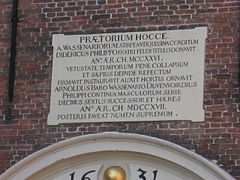Duivenvoorde Castle

Kasteel Duivenvoorde (Castle Duivenvoorde) is in the town of Voorschoten, Zuid-Holland in the Netherlands. It was first mentioned in 1226, making it one of the older castles in Zuid-Holland
The castle is remarkable in that it was never sold; it was inherited by several different noble houses, sometimes through the matrilineal line, something that can be said of very few Dutch castles. For the first five centuries of its history, the castle was owned by one and the same family, namely the Van Duivenvoordes, who gave their name - at that time, van Duvenvoirde - to the castle. Though the castle was named thus, the van Duvenvoirdes properly formed part of the House of Wassenaer, an ancient noble family that has played an important role in Dutch history. Toward the end of the 17th century an owner of Kasteel Duivenvoorde, Johan, retook the name of van Wassenaar Therefor, though the same family remained to live in the House, this was ow under a different name.
The Roman plaques

In 1717, two Roman stones were installed as plaques in the front hall.
The larger of the two stones, dated between 196 and 198 AD, has an inscription on the front about the repair of an armory by Roman troops; the text on the other side is older, dating from somewhere between 103 and 111 AD. In the making of the newer text, the stone was made smaller, damaging the older text.
The smaller stone has a text that, through knowledge of the people named there in, can date the stone to around 205 AD.
Legend holds that both stones come from Brittenburg, the presumed Roman ruins that resurfaced above water off the coast of Katwijk in 1520. However, this cannot be true of the larger stone, because a military chronicle discovered in 1517 was indisputably taken from the text of the larger stone, thus implying that the stone was found in 1502 while plowing a piece of land near the Roomburg cloister.
Current status
The last private owner of the castle was Jonkvrouwe Ludolphine Henriette, Baroness Schimmelpenninck van der Oye (1891-1965). Knowing that with her death the house would be sold and the furniture dispersed, including the collections of portraits, porcelain and clothing and textiles, she decided to close the house and leave it in the care of a foundation for restoration.
The aim of the restoration was to restore the castle to its appearance in 1717, though this has not always been possible. The terrace from 1844 has been maintained, and the opening of previously sealed windows to allow more light into the living room has taken away some of the symmetry. The interior has been repainted to match the colors of 1717, and later piecemeal work has been done on the ceiling.
The Duivenvoorde Foundation aims to turn Kasteel Duivenvoorde into a museum and put the historic furniture on display. However, the central part of the house and the north wing have not been made into a museum, but have been made to look as though they were still in an inhabited house, giving the visitor the impression of going back in time and walking around a house from which the owners are only temporarily absent.
The south wing is in fact still inhabited; Ludolphine Emilie van Haersma Buma, Baroness Schimmelpenninck van der Oye has lived there since 2003. Her brother lives in the castle's garden house.
